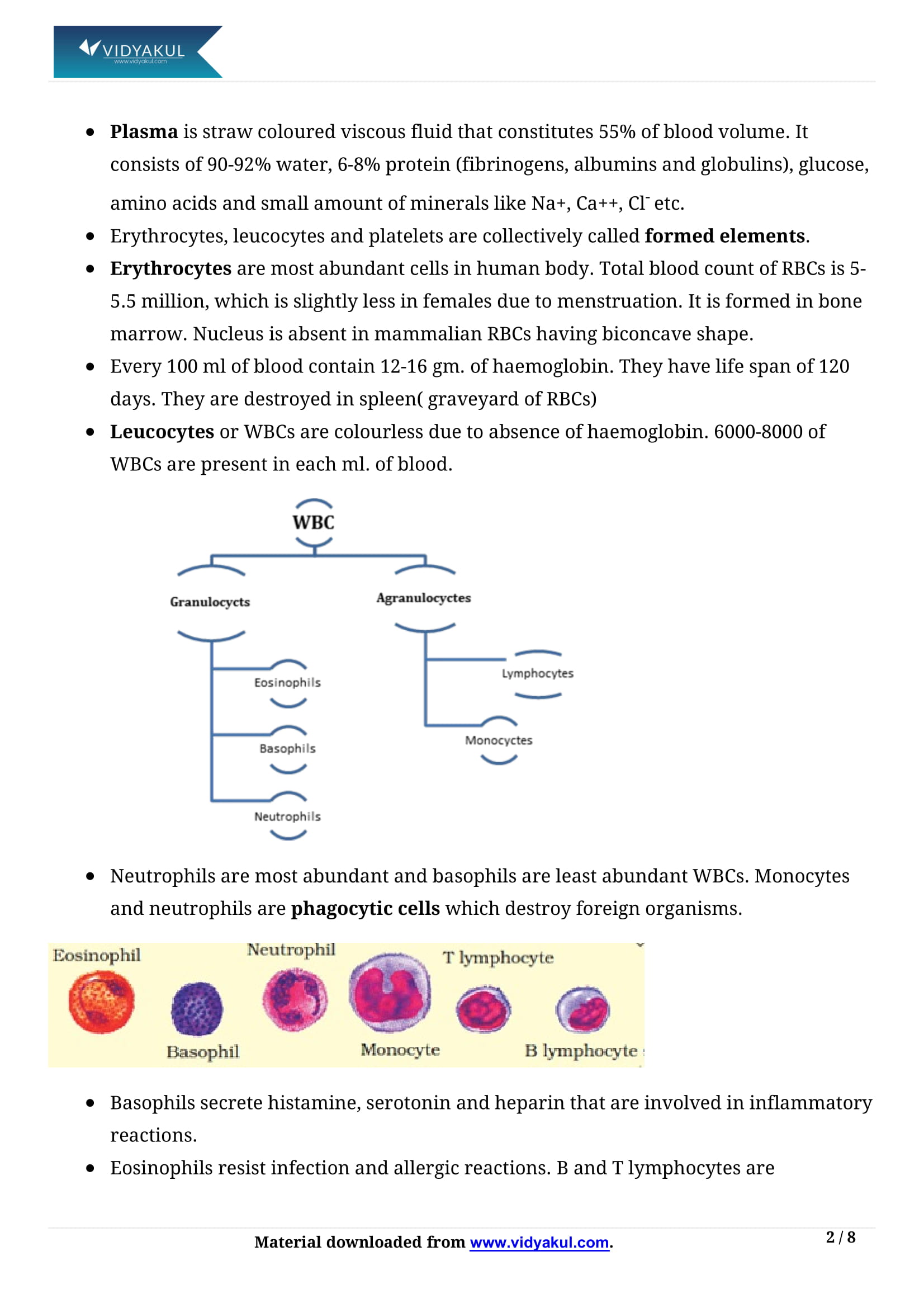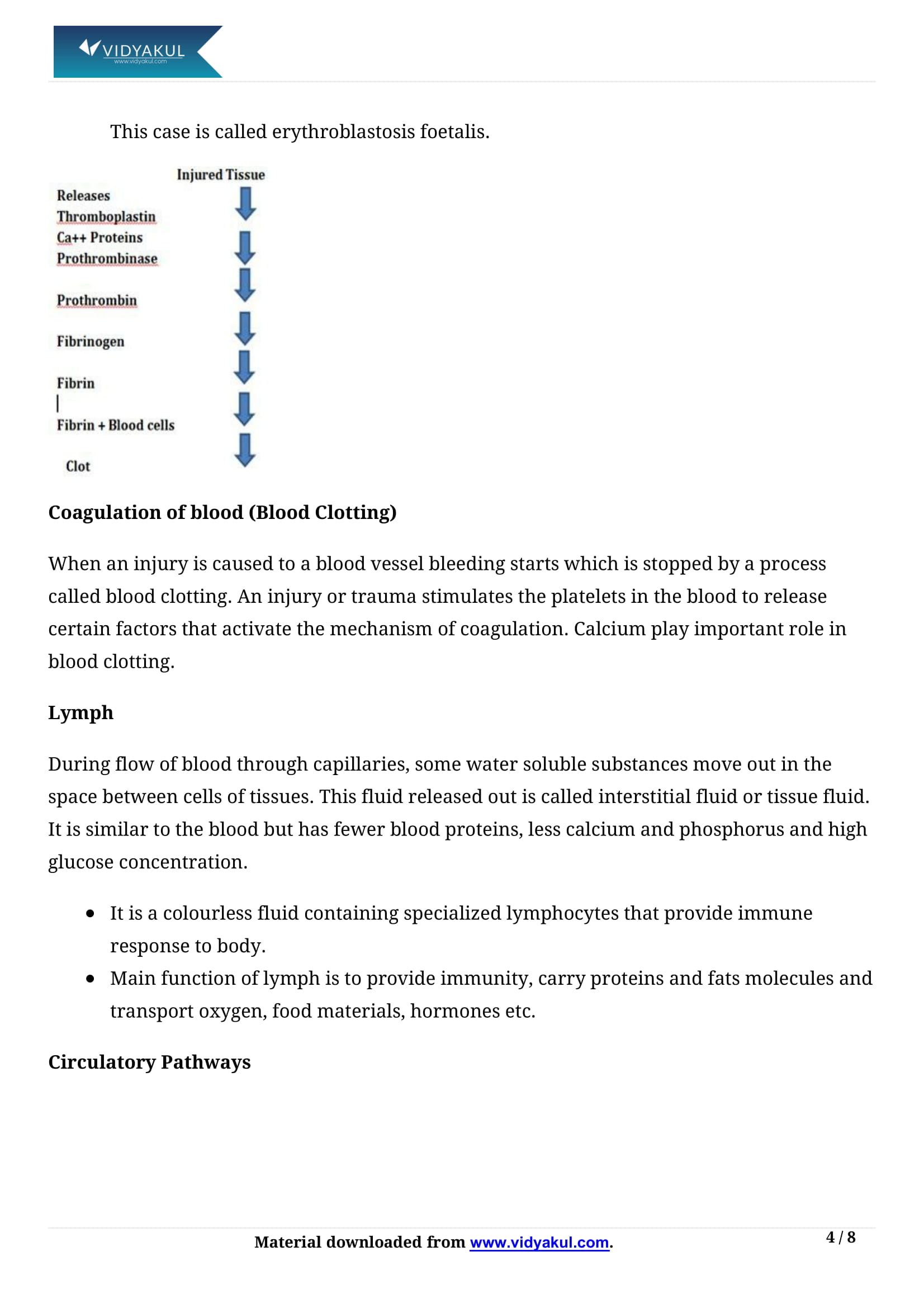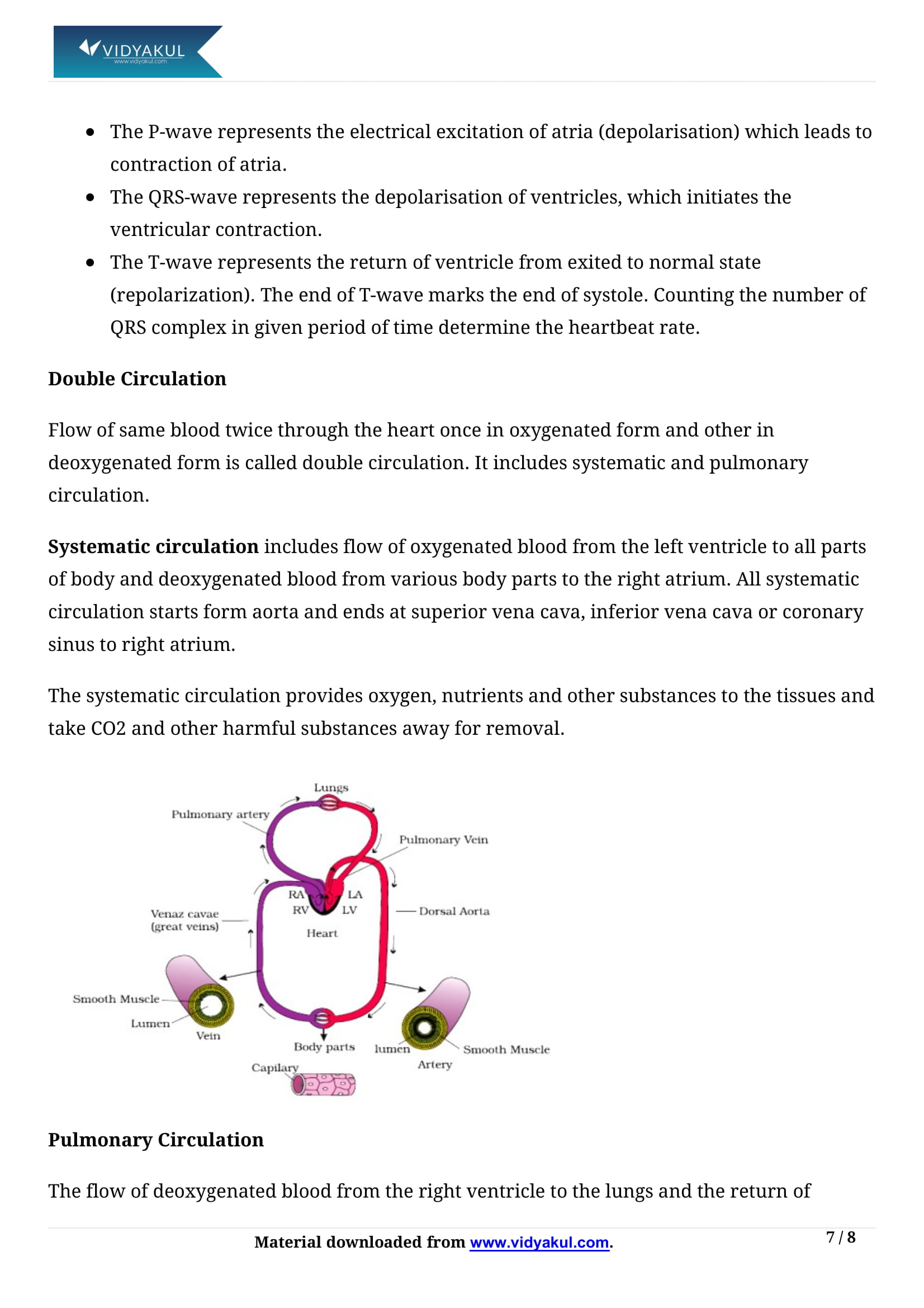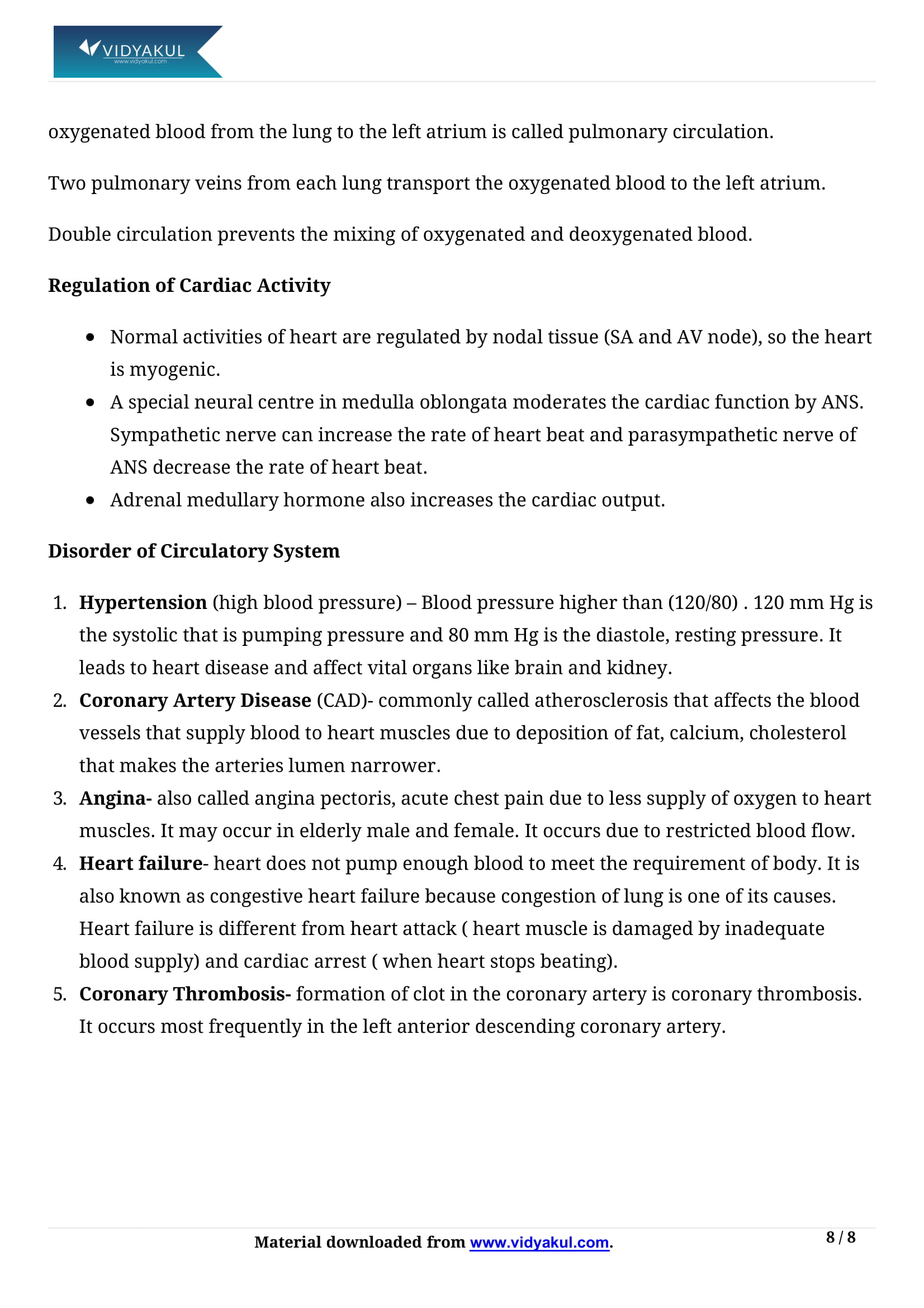Body Fluids and Circulation Class 11 Notes

Chapter 18 Body Fluids and Circulation
Chapter 18, "Body Fluids and Circulation," is an important chapter and should be studied closely by all 11th grade biology students. To help students through this, we have provided a complete NCERT notes in this article. The set of notes provided by Vidyakul are created by experienced professionals and involve a large amount of research.
You can also find a detailed description of each problem in the chapter "Humatic Fluids and Circulation". Students need to have a good understanding of the body fluids and circulatory field in order to do well on the 11th grade exam, which will help them on competitive exams such as the NEET. Students can also download these NCERT notes for offline study. Read on to find out more.
CBSE CLASS 11 BIOLOGY CH-18
Points to Remember
Plasma is straw coloured viscous fluid that constitutes 55% of blood volume. It consists of 90-92% water, 6-8% protein (fibrinogens, albumins and globulins), glucose, amino acids and small amount of minerals like Na+, Ca++, Cl– etc.
Erythrocytes, leucocytes and platelets are collectively called formed elements.
Erythrocytes are most abundant cells in human body. Total blood count of RBCs is 5-5.5 million, which is slightly less in females due to menstruation. It is formed in bone marrow. Nucleus is absent in mammalian RBCs having biconcave shape.
Every 100 ml of blood contain 12-16 gm. of haemoglobin. They have life span of 120 days. They are destroyed in spleen( graveyard of RBCs)
Leucocytes or WBCs are colourless due to absence of haemoglobin. 6000-8000 of WBCs are present in each ml. of blood.
Basophils secrete histamine, serotonin and heparin that are involved in inflammatory reactions.
Eosinophils resist infection and allergic reactions. B and T lymphocytes are responsible for immune response of the body.
Thrombocytes or platelets are cell fragments produced from megakaryocytes in bone marrow. 150000-350000 platelets are present in each ml of blood. Platelets are involved in clotting or coagulation of blood in case of injuries.
Blood Groups – blood of human beings differ in certain aspects although it appear same in all individuals. Two main types of grouping are ABO and Rh.
During blood transfusion, blood of donor has to be matched with blood of recipients to avoid clumping of RBCs.
Group ‘O’ blood can be donated to any individual with any blood group, so it is called universal donor.
Person with ‘AB’ blood group can receive blood from any person of any group, so it is called universal recipient.
Rh grouping – Rh antigen (similar to Rhesus monkey) are observed on surface of RBCs of majority of individuals (about 80%). Such people are called Rh positive () and those in whom this antigen is absent are called Rh negative ().
Erythroblastosis foetalis– if father blood is Rh+ and mother blood is , the foetus blood is Rh+. During the delivery of first child there is a possibility of exposure of mother blood with foetus blood to develop antibodies in mother blood. In subsequent pregnancy the mother’s blood can leak into foetus blood and destroy the foetus RBC. This case is called erythroblastosis foetalis.
Topics and Sub-topics
We have provided the NCERT notes for Class 11 Biology Chapter 18. Let us take a look at the sections and subsections of this chapter:
Frequently Asked Questions
Describe the Rh-incompatibility in humans.
Rh antigen is seen on the RBC surface of majority humans, these are called Rh-positive individuals and when the antigen is absent they are Rh-negative individuals. Both these individuals are phenotypically normal individuals. However, in these individuals, a problem emerges during pregnancy or transfusion of blood. The first blood transfusion from Rh-positive blood to the RI-T individual leads to no harm as the Rh-negative person acquires antibodies or Rh factors in their blood. During the second transfusion of blood, from Rh-positive blood to the Rh-negative individual, the antibodies already formed attack to destruct the RBC of the donor. In pregnancy, if the father’s blood is Rh-positive and the mother’s blood is Rh-negative, the blood of the fetus will be Rh-positive, which leads to serious issues. The Rh antigens of the fetus are not exposed to the Rh-positive blood of the mother during the first pregnancy, as they are separated from the placenta. But in the succeeding Rh-positive fetus, the anti-Rh factors from the mother destruct the RBCs of the fetus as the blood mixes which causes hemolytic disease in the newborn(HDN) known as erythroblastosis fetalis. This can be prevented through the administration of anti-Rh antibodies to the mother after the delivery of the first child.
Explain the events in the cardiac cycle. Describe ‘double circulation’.
The cardiac cycle makes for one heartbeat i.e., one complete cycle of relaxation and contraction occurring in the cardiac muscles, where one heartbeat constitutes for contraction(systole) and relaxation(diastole) of atria and ventricles. The events are:
Atrial systole – Due to the wave of contraction, the atria contracts, that is triggered by the sino-atrial node. As the bicuspid and the tricuspid valve are open, the blood is forced into the ventricles.
Beginning of the ventricular systole – The wave of contraction triggered by the AV node causes the contraction of ventricles that leads to the bicuspid and tricuspid valve to close and hence generates the first heartbeat sound – “lub”
Complete Ventricular Systole – After the ventricles contract, blood flows into the pulmonary trunk and aorta due to the opening of the semilunar valves.
Beginning of the ventricular diastole – The ventricles relax while the semilunar valves remain closed, which causes the second heart sound – dub.
Complete ventricular diastole – A fall in pressure of ventricles causes the opening of the bicuspid and the tricuspid valve and hence blood flows from the atria to the ventricles. Blood does not flow in the backward direction due to the contraction of the heart as the pressure inside the relaxed ventricles is lesser in comparison to the atria and the veins.
Double circulation – Two distinct pathways are present in birds and mammals. The left and the right atria receive oxygenated and deoxygenated blood respectively which is passed on the ventricles of the same sides. The ventricles then pump it out of the heart without mixing it up.
Explain:
a) Hypertension
b) Coronary Artery Disease
a) Hypertension – High blood pressure is the most commonly occurring disease that affects the heart, blood vessels, brain, kidney an eyes. Normal blood pressure is – 120/80. If it goes beyond 140mHg and 90 mm Hg, it is high blood pressure or hypertension. Its causes are:
Coronary heart vessels get blocked
Smoking tobacco speeds up the process of heart rate. It tightens blood vessels and increases blood pressure.
b) Coronary Artery Disease (CAD) – It arises due to the deposition of fatty substances on the walls of the arteries which causes atherosclerotic plaques. This leads to the lumen of the artery to diminish thereby blocking the flow of blood, which can sometimes block the arteries completely leading to a heart attack.
Practice Questions
What are the two types of the circulatory system?
What are the symptoms of Hypertension?
List out the functions of:
Lymphatic System.
Pulmonary vein.
Lymphocytes.
Why are thrombocytes necessary for blood coagulation?
What is the functional role of the lymphatic system?
Plasma is straw coloured viscous fluid that constitutes 55% of blood volume. It consists of 90-92% water, 6-8% protein (fibrinogens, albumins and globulins), glucose, amino acids and small amount of minerals like Na+, Ca++, Cl– etc.
Erythrocytes, leucocytes and platelets are collectively called formed elements.
Erythrocytes are most abundant cells in human body. Total blood count of RBCs is 5-5.5 million, which is slightly less in females due to menstruation. It is formed in bone marrow. Nucleus is absent in mammalian RBCs having biconcave shape.
Every 100 ml of blood contain 12-16 gm. of haemoglobin. They have life span of 120 days. They are destroyed in spleen( graveyard of RBCs)
Leucocytes or WBCs are colourless due to absence of haemoglobin. 6000-8000 of WBCs are present in each ml. of blood.
Basophils secrete histamine, serotonin and heparin that are involved in inflammatory reactions.
Eosinophils resist infection and allergic reactions. B and T lymphocytes are responsible for immune response of the body.
During blood transfusion, blood of donor has to be matched with blood of recipients to avoid clumping of RBCs.
Group ‘O’ blood can be donated to any individual with any blood group, so it is called universal donor.
Person with ‘AB’ blood group can receive blood from any person of any group, so it is called universal recipient.
Erythroblastosis foetalis– if father blood is Rh+ and mother blood is , the foetus blood is Rh+. During the delivery of first child there is a possibility of exposure of mother blood with foetus blood to develop antibodies in mother blood. In subsequent pregnancy the mother’s blood can leak into foetus blood and destroy the foetus RBC. This case is called erythroblastosis foetalis.
Describe the Rh-incompatibility in humans.
Explain the events in the cardiac cycle. Describe ‘double circulation’.
Atrial systole – Due to the wave of contraction, the atria contracts, that is triggered by the sino-atrial node. As the bicuspid and the tricuspid valve are open, the blood is forced into the ventricles.
Beginning of the ventricular systole – The wave of contraction triggered by the AV node causes the contraction of ventricles that leads to the bicuspid and tricuspid valve to close and hence generates the first heartbeat sound – “lub”
Complete Ventricular Systole – After the ventricles contract, blood flows into the pulmonary trunk and aorta due to the opening of the semilunar valves.
Beginning of the ventricular diastole – The ventricles relax while the semilunar valves remain closed, which causes the second heart sound – dub.
Complete ventricular diastole – A fall in pressure of ventricles causes the opening of the bicuspid and the tricuspid valve and hence blood flows from the atria to the ventricles. Blood does not flow in the backward direction due to the contraction of the heart as the pressure inside the relaxed ventricles is lesser in comparison to the atria and the veins.
Explain:
Coronary heart vessels get blocked
Smoking tobacco speeds up the process of heart rate. It tightens blood vessels and increases blood pressure.
What are the two types of the circulatory system?
What are the symptoms of Hypertension?
List out the functions of:
Lymphatic System.
Pulmonary vein.
Lymphocytes.
Why are thrombocytes necessary for blood coagulation?
What is the functional role of the lymphatic system?
Learn more about it in Body Fluids and Circulation Class 11 Notes pdf.
Download this solution for FREE Download this PDF
Download Vidyakul App for more Important videos, PDF's and Free video lectures.











